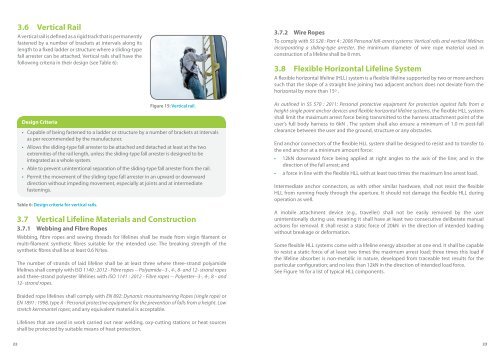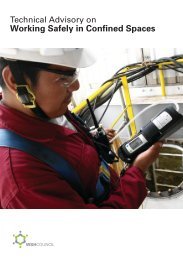HERE - Workplace Safety and Health Council
HERE - Workplace Safety and Health Council
HERE - Workplace Safety and Health Council
You also want an ePaper? Increase the reach of your titles
YUMPU automatically turns print PDFs into web optimized ePapers that Google loves.
3.6 Vertical RailA vertical rail is defined as a rigid track that is permanentlyfastened by a number of brackets at intervals along itslength to a fixed ladder or structure where a sliding-typefall arrester can be attached. Vertical rails shall have thefollowing criteria in their design (see Table 6):Design CriteriaFigure 15: Vertical rail.• Capable of being fastened to a ladder or structure by a number of brackets at intervalsas per recommended by the manufacturer.• Allows the sliding-type fall arrester to be attached <strong>and</strong> detached at least at the twoextremities of the rail length, unless the sliding-type fall arrester is designed to beintegrated as a whole system.• Able to prevent unintentional separation of the sliding-type fall arrester from the rail.• Permit the movement of the sliding-type fall arrester in an upward or downwarddirection without impeding movement, especially at joints <strong>and</strong> at intermediatefastenings.Table 6: Design criteria for vertical rails.3.7 Vertical Lifeline Materials <strong>and</strong> Construction3.7.1 Webbing <strong>and</strong> Fibre RopesWebbing, fibre ropes <strong>and</strong> sewing threads for lifelines shall be made from virgin filament ormulti-filament synthetic fibres suitable for the intended use. The breaking strength of thesynthetic fibres shall be at least 0.6 N/tex.The number of str<strong>and</strong>s of laid lifeline shall be at least three where three-str<strong>and</strong> polyamidelifelines shall comply with ISO 1140 : 2012 - Fibre ropes -- Polyamide--3-, 4-, 8- <strong>and</strong> 12- str<strong>and</strong> ropes<strong>and</strong> three-str<strong>and</strong> polyester lifelines with ISO 1141 : 2012 - Fibre ropes -- Polyester--3-, 4-, 8 - <strong>and</strong>12- str<strong>and</strong> ropes.3.7.2 Wire RopesTo comply with SS 528 : Part 4 : 2006 Personal fall-arrest systems: Vertical rails <strong>and</strong> vertical lifelinesincorporating a sliding-type arrester, the minimum diameter of wire rope material used inconstruction of a lifeline shall be 8 mm.3.8 Flexible Horizontal Lifeline SystemA flexible horizontal lifeline (HLL) system is a flexible lifeline supported by two or more anchorssuch that the slope of a straight line joining two adjacent anchors does not deviate from thehorizontal by more than 15º .As outlined in SS 570 : 2011: Personal protective equipment for protection against falls from aheight-single point anchor devices <strong>and</strong> flexible horizontal lifeline systems, the flexible HLL systemshall limit the maximum arrest force being transmitted to the harness attachment point of theuser’s full body harness to 6kN . The system shall also ensure a minimum of 1.0 m post-fallclearance between the user <strong>and</strong> the ground, structure or any obstacles.End anchor connectors of the flexible HLL system shall be designed to resist <strong>and</strong> to transfer tothe end anchor at a minimum amount force:• 12kN downward force being applied at right angles to the axis of the line; <strong>and</strong> in thedirection of the fall arrest; <strong>and</strong>• a force in line with the flexible HLL with at least two times the maximum line arrest load.Intermediate anchor connectors, as with other similar hardware, shall not resist the flexibleHLL from running freely through the aperture. It should not damage the flexible HLL duringoperation as well.A mobile attachment device (e.g., traveller) shall not be easily removed by the userunintentionally during use, meaning it shall have at least two consecutive deliberate manualactions for removal. It shall resist a static force of 20kN in the direction of intended loadingwithout breakage or deformation.Some flexible HLL systems come with a lifeline energy absorber at one end. It shall be capableto resist a static force of at least two times the maximum arrest load; three times this load ifthe lifeline absorber is non-metallic in nature, developed from traceable test results for theparticular configuration; <strong>and</strong> no less than 12kN in the direction of intended load force.See Figure 16 for a list of typical HLL components.Braided rope lifelines shall comply with EN 892: Dynamic mountaineering Ropes (single rope) orEN 1891 : 1998, type A - Personal protective equipment for the prevention of falls from a height. Lowstretch kernmantel ropes; <strong>and</strong> any equivalent material is acceptable.Lifelines that are used in work carried out near welding, oxy-cutting stations or heat sourcesshall be protected by suitable means of heat protection.22 23
















